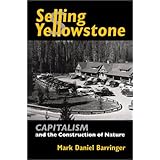
Average Reviews:

(More customer reviews)Are you looking to buy Selling Yellowstone: Capitalism and the Construction of Nature? Here is the right place to find the great deals. we can offer discounts of up to 90% on Selling Yellowstone: Capitalism and the Construction of Nature. Check out the link below:
>> Click Here to See Compare Prices and Get the Best Offers
Selling Yellowstone: Capitalism and the Construction of Nature ReviewLike many academic tomes, this book's subtitles imply a grandeur and generality that isn't to be found in the book. In this case, even the title overreaches. Barringer is really telling the story of the Yellowstone Park Company (YPC), the major concessioner for 75 years. The YPC had to fend off competitors, or buy them out, and then work with the National Park Service (NPS) to enforce its monopoly. Eventually it was unable to keep up with changes in tourism, and the book effectively ends in 1966 when the NPS terminated the YPC contract.Barringer views both the YPC and NPS as partners sharing a vision and similar weaknesses. Both saw Yellowstone primarily as a resort tourist destination, the experience of which had to be constructed and delivered to tourists in a particular way. This led to the massive construction project of Mission 66, which sparked a public reaction against the park service and threatened YPC's financial health. Neither park service nor concessionaire was well equipped to handle changes in the public view of national parks, as tourism became a possible threat to Yellowstone's natural resources.
This is a nice hook for the story but it overstates the case. The NPS has continued to push a tourist-based vision, built around concessions and automobiles, that represents a continuation of the story. The particular construction of nature in Yellowstone wasn't much different than the construction of nature in other parks - - which makes one wonder whether the outcome in Yellowstone was essentially inevitable and not the result of what YP Company did. Barringer might try to imagine alternatives in order to show where agents had choices to take other paths, and whether structure largely forced the outcome we see.
The meat of the book is a conventional, if short, history of the YP Company against the background of other concessioners, other parks, and NPS history. The introduction has a great overview of the transition from the myths of the Old West to the myths of the New West, and the conclusion has a very useful summary of the central argument. Those framing chapters are worth the price of admission.Selling Yellowstone: Capitalism and the Construction of Nature OverviewFor over a century, Yellowstone National Park has been a monument to wildness in America. But long before flames swept through Yellowstone in 1988, that wildness had come under fire from encroachments that were making the park one of our nation's most commodified pieces of real estate.For as long as they've existed, parks like Yellowstone have been the scene of some of the most intensive commercial activity in the American West. Selling Yellowstone recounts the story of such activities in our oldest park from the 1870s through the 1960s. It is the first book to examine critically the place of business in the development of America's national parks, demonstrating the prominent role played by profit-driven entrepreneurs in shaping the physical landscape of what is generally perceived as unaltered wilderness.Challenging popular perceptions that our national parks are protected from commercialism, Mark Barringer reveals how businessmen, with the support of the National Park Service, marketed Yellowstone as a museum of mythology: a landscape created to look like what Americans wanted to believe the Old West once was. Together, the NPS and the concessionaires--particularly Harry W. Child's Yellowstone Park Company--altered the park repeatedly to fit a desired image and then creatively promoted it for mass consumption. As a result, the concessionaires virtually owned Yellowstone, selling it piecemeal to receptive customers as if it were an inexhaustible commodity.First marketed as a nature museum to be viewed from the comfort of stagecoach seats or hotel room windows, the park was transformed from a wilderness preserve to a series of roadside attractions. Roads were built to geysers and waterfalls; wolves were eliminated and bison were bred; visitors were given a choice between comfortable hotels and more rustic lodges and camps. The Yellowstone Park Company sought to meet all of the public's expectations, reaping the profits from satisfying American idealizations.Contemporary environmental attitudes eventually forced significant policy changes in the parks, but shifting political winds continue to determine such matters as snowmobile access to Yellowstone. Barringer's book contributes to the ongoing debate over the character and limits of the social construction of nature as it raises important questions about what our national parks represent, why so many people continue to feel so strongly about them, and what must be done to protect them.This book is part of the Development of Western Resources series.
Want to learn more information about Selling Yellowstone: Capitalism and the Construction of Nature?
>> Click Here to See All Customer Reviews & Ratings Now
0 comments:
Post a Comment